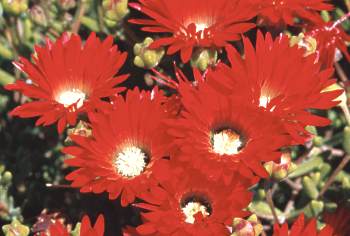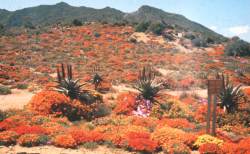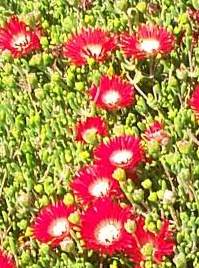Drosanthemum speciosum
Drosanthemum speciosum (Haw.) Schwantes
Family: Aizoaceae
Common names: Worcester-Robertson vygie, Red ice-plant (Eng.), Bergvygie (Afr.)
Introduction
Brilliant, vibrant, stunning, barely describe this vygie, which is one of the plants that makes the Karoo Desert National Botanical Garden in Worcester famous for its spring display.

Description
Description
Drosanthemum speciosum is a very colourful low-growing shrublet that grows to about 600 mm. They are fast-growing with small succulent leaves, and the scarlet, yellow or orange flowers bloom in spring to summer. (September-February). People refer to these plants as 'municipal workers' as their flowers open at around 9 a.m. and close around 5 p.m.

Conservation Status
Status
This species is widespread and not in danger of extinction. It is assessed as Least Concern (LC) on the Red List of South African Plants.
Distribution and habitat
Distribution description
The natural distribution is in the Western Cape, in the Worcester-Robertson Karoo and the Little Karoo. It grows on shale slopes in Succulent Karoo, Fynbos and Renosterveld from Worcester to Barrydale.

Derivation of name and historical aspects
History
The genus name Drosanthemum, was derived from the Greek words drosos, meaning dew and anthos meaning flower, describing the glittering water cells on the leaves of many species that resemble drops of dew.
Uses
Use
The Drosanthemum species are perhaps the most popular and spectacular of all garden mesembs. Few other plants can match the glowing intensity of a stand of these mesembs in full flower.

Growing Drosanthemum speciosum
Grow
In the garden the plants must be replaced after three years as they become woody and flower less. Plants can be watered moderately in winter, but should be kept fairly dry in summer.
All drosanthemums are very hardy plants, thus making them ideal water-wise plants for drier gardens. They can be used in the open garden or mixed borders. Today they are found in Mediterranean gardens throughout the world. The species has many colour forms to choose from, thus allowing the gardener to mix colours with other interesting plants. If not in the open garden, plants can be grown in a well-drained rock garden, on a bank to form a ground cover, or even in flower boxes to brighten a dull, sunny patio.
They grow easily from seeds that are produced in seed capsules in late summer. Sow the seeds in river sand in the autumn or summer (April or December), or scatter them over larger areas on a still day, after which river sand must be lightly sprinkled over the sown area. Cuttings usually root easily and are best taken after fruiting, from midsummer to autumn (December to April in South Africa).
References
- Germishuizen, G., Meyer, N.L., Steenkamp, Y. & Keith, M. (eds) 2006. A Checklist of South African plants. Southern African Botanical Diversity Network Report No. 41. SABONET, Pretoria.
- JOFFE, P. 1993. The gardener's guide to South African plants. Tafelberg, Cape Town.
- SMITH, G., et al. 1998. Mesembs of the world. Briza Publications, Pretoria.
Credits
Werner Voigt
Karoo Desert National Botanical Garden
August 2002
Plant Attributes:
Plant Type: Shrub, Succulent
SA Distribution: Western Cape
Soil type: Sandy, Loam
Flowering season: Spring
PH: Acid, Neutral
Flower colour: Red, Yellow, Orange
Aspect: Full Sun
Gardening skill: Easy
Special Features:
Horticultural zones








Rate this article
Article well written and informative
Rate this plant
Is this an interesting plant?
Login to add your Comment
Back to topNot registered yet? Click here to register.